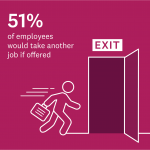If you’re an employer or HR professional, you know that attrition is expensive, and that employee engagement is extremely important. Read on to learn more about the root causes of turnover—and what you can do to mitigate them.
Half of US employees are ready to abandon ship
In a recent survey, we found that 51% of employees would take another job if offered. And while a number of factors play into an employee’s ultimate decision to leave, the root cause typically stems from disengagement.

Some of the top causes of disengagement cited were:
- Lack of job satisfaction
- Low personal engagement
- Absence of a clear path for development
- No purpose alignment
Employers should take heed: research also found that only 33% of employees are engaged, and only 22% of them strongly agree that their leadership has a clear direction for their organization.
Interestingly, 91% of employees say last time they switched roles, they left their company to do so—a sign that employers aren’t giving workers strong enough reasons to stay.
Related: Could having a customer-centric culture lead to better employee engagement? New research shows that companies that put customers first are significantly more likely to have employees who find their jobs meaningful and plan to stay longer.
Disengagement damages more than your bottom line
One study estimates that disengaged employees cost the US economy between $450-550 billion in lost productivity annually. Keep in mind this number doesn’t take into account turnover and other consequences.

Some of the effects of disengagement are easily quantifiable:
- Lower productivity
- Less new business closed
- Poor customer service and errors
- Hiring and training a replacement
Other byproducts are tougher to calculate—but still potentially ruinous:
- Susceptibility to burnout
- Less innovation
- Spreading negative attitudes, harming morale
- Damaging brand via poor customer experience
Two steps to help retain your employees
Increasing engagement isn’t easy. It’s a complex process that involves your most complex resource: people.
Nevertheless, here are two steps you can take to start engaging your employees and lowering turnover.
1. Make increasing engagement an organizational priority
Communicating to your employees that your company is taking an active interest in their needs is the first step to increasing engagement. When you signal that your people matter to you as people, they’ll take notice. Additionally, be as transparent as possible with how you plan to collect this information, as well as how—and how often—you intend to use it.
Of course, you also need to align with top management to tie employee engagement to business metrics. One example is how many businesses are linking NPS to profit. Employee engagement is similar in that it needs support at the highest organizational level to affect a business’s bottom line.
2. Get insights from your data faster
Traditionally, analyzing employee engagement survey data is a painstaking process that takes months. From multiple choice to open text, you’ll have to sift through a high volume of data to unearth the insights you need to succeed. Adopt a solution that automates or otherwise expedites this process for you, freeing you up to spend more time taking action.
The journey doesn’t stop here
When it comes to increasing engagement, reducing turnover, and boosting your bottom line, what you’ve read here is just the tip of the iceberg. Download our eGuide to learn more.
Methodology
This data was gathered by surveying two national samples comprising 8,003 adults who were employed full-time. The samples were combined and weighted for age, race, sex, education, employment status, and geography to reflect the demographic composition of the United States.



